Ventilation of a vegetable pit in a garage: organization of air exchange in a garage vegetable store
It is not enough to grow a crop in a country house or a personal plot in a village; it still needs to be preserved somehow until spring. And almost the only right option here is a personal vegetable store. Moreover, often a similar cellar is equipped in a garage under a viewing hole. So it turns out cheaper, and everything turns out to be in one place, and the temperature inside does not drop below zero.
But you must admit, if you dig a pit under the garage building and sprinkle potatoes with carrots there, then the vegetables will not last even until winter. Due to excess moisture, they simply rot. Only properly equipped ventilation in the vegetable pit in the garage is a guarantee of the safety of supplies.
We will tell you how to properly equip the storage for crops under the garage with an impeccably functioning ventilation system. In the article we presented, all the nuances and rules are laid out in detail. Our tips will help independent home craftsmen achieve an excellent result.
The content of the article:
How much does a vegetable pit need ventilation
The classic vegetable storehouse under a private garage (box) is a room 2–2.5 meters wide / up to 2 meters high. The descent into it is usually arranged from the viewing hole using a ladder.
As a result, the cellar for vegetables and cans with pickles is obviously lower than the level of soil freezing, which ensures that the temperature in it remains above zero, even in winter.
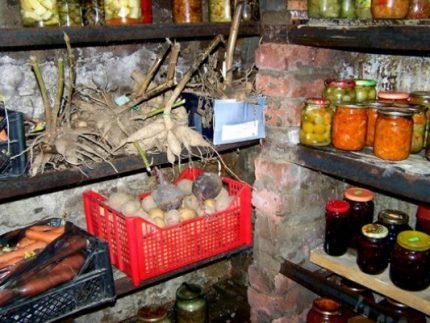
Ventilation in the garage vegetable warehouse is equipped to:
- keep the air temperature in the pit at a level of 1 to +10 0C throughout the year;
- remove excess moisture and carbon dioxide with ethylene from the cellar;
- to provide constant air exchange with the influx into the street air.
During storage, vegetables “breathe” and continue to ripen or gradually begin to rot. As a result of these processes, heat and moisture are constantly released.And if they are not removed from the vegetable store, then the humidity inside will reach 95-100%, and the temperature will rise above 10-15 0C. And in the end, this leads to condensation and the development of rot with subsequent loss of crop.
Ideally, the following conditions should be provided in a vegetable pit under the garage:
- temperature - plus 1–5 0WITH;
- humidity - 85–90%;
- air exchange - 1 time / hour (about 50–100 m3/ ton of vegetables * hour);
- light - dimming with no direct sunlight; lighting is turned on only when people are in the cellar.
In reality, these indicators can only be achieved by installing in the vegetable pit under the garage a ventilation system with forced airand. Moreover, it will have to include automation in its composition for stable maintenance of the microclimate.
This type of ventilation will cost several hundred thousand rubles. Spending such amounts is completely unprofitable. Therefore, more often than not, ventilation in the garage vegetable storehouse is built in the usual natural pattern of a pair of pipes.
Ventilation system design
Ventilation in the garage vegetable store can be natural and forced. The first option is cheaper, and the second is more effective. Another nuance - in the second case, the garage must be electrified, the fan for pumping air works from the mains.
If everything is done according to SNiPs, then when preparing the draft ventilation system in a vegetable pit, it is necessary to take into account:
- Winter and summer temperature indicators for the region.
- Groundwater level and soil freezing.
- The presence near the garage building of underground utilities (especially heating mains and water supply systems).
- Types of vegetables and root crops that are supposed to be stored in the cellar.
- The volume of supplies filled up for storage and the cubic capacity of the store.
- Presence / absence of insulation and concrete floor in the pit.
In order for potatoes, cabbage in forks, carrots, radishes and beets to remain in the vegetable store for as long as possible, they should be kept in different compartments, if possible with a different microclimate.
But in a small personal garage it is impossible to create such conditions due to the limited space available. Therefore, in the case under consideration, natural ventilation is usually organized. It is cheaper, easier to install with your own hands and does not require electricity.
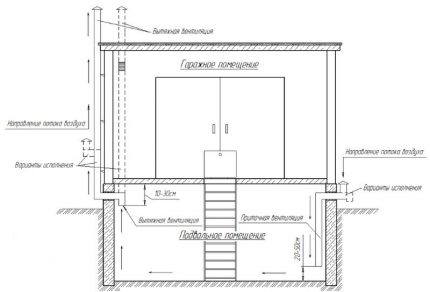
When organizing ventilation in a vegetable store under a garage, the following points should be considered:
- Air from the garage with exhaust from the car must not enter the vegetable pit.
- The air from the cellar, saturated with moisture from vegetables, should not enter the inspection hole and rise under the car.
- A forced ventilation system needs electricity and constant supervision.
- A system with natural air exchange in the summer almost stops working in the heat, and in the winter in severe frosts (if the inflow is not blocked) the cellar can freeze.
Vegetable pit is a constant source of moisture. But the descent into it in a private garage is usually organized through an observation pit.
If there is no maximally tight door between these two rooms, then moist air below the vegetables will rise under the bottom of the machine. As a result, the car already from such a microclimate will begin to rust and rot.
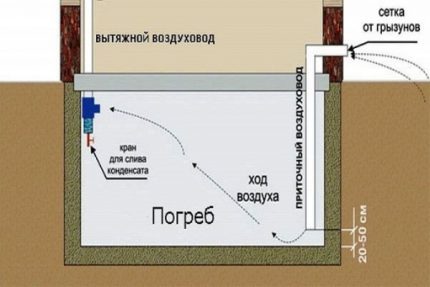
Cold air descends to the floor, and warm rises to the ceiling. This is pure physics. And the higher the temperature difference, the faster such a circulation of air masses occurs.
If the supply pipe from the street is brought to the floor of the vegetable pit, and the exhaust pipe is mounted outside the ceiling or connected to a common garage hood, then in such a duct system a natural draft is formed.
And if the ventilation ducts are designed correctly, then the air exchange will be more than enough to remove excess heat and moisture from the vegetable store to the street.
If the supply and exhaust pipes are narrowed, the air exchange rate in the cellar of the garage will be low. And if you set them too wide, the circulation will be excessive. In the first case, the pit will be too warm and humid, and in the second, the vegetable storehouse may freeze in winter.
The best option for the duct diameter for a natural ventilation system in a 3–6 m garage cellar2 - 100-150 mm.
The choice of pipes for ducts in the garage
To organize natural ventilation in the garage box itself, it is enough to build one ventilation duct in it through the roof of the building. In this case, air will flow through the open door and vents on both sides of it below the wall.

For the device for ventilation of a vegetable store in a garage, the following types of ducts:
- plastic (PVC or polyethylene);
- galvanized iron;
- asbestos;
- aluminum.
Asbestos and PVC option will be the cheapest. Moreover, if the first is non-combustible, then the second does not absorb moisture. Metal pipes are more expensive, but more durable and calmer tolerate frost.
Condensate and ice
It is impossible to completely get rid of constantly forming moisture in the vegetable store. It in the pit comes from vegetables, the ground underfoot and condensation from the walls. At the same time, it is also not recommended to dry the air in the cellar too much. This is harmful to stored supplies.
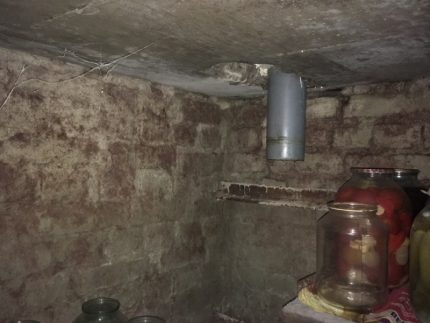
If warm air enters the cold cellar on the walls and everyone in the vegetable store, condensation instantly drops out. If the hood does not work well, the hood will remain inside and contribute to the development of mold on vegetables. And with a sharp cooling, it will instantly turn into ice, which is also unpleasant.
The wider the ventilation pipes, the stronger the air exchange. However, it is good in the summer, but completely superfluous in the winter. In winter, the air flow on the contrary needs to be minimized as much as possible so as not to unnecessarily lower the temperature inside.
To ensure maximum control over what is happening in the vegetable pit, you should consider:
- adjusting valve on the supply pipe;
- the possibility of completely blocking the inflow and exhaust of air in case of severe frost;
- insulation of both ducts;
- the ability to install an exhaust electric fan for forced drying of the cellar.
Also, if there is lighting in the basement, condensation can cause a short circuit. Therefore, the better the vegetable pit itself is insulated, the garage above it and the ventilation pipe, the better.
Installation of ventilation in the vegetable store
Before you start doing ventilation in the vegetable pit of the garage, you should calculate everything and prepare all the necessary materials in advance. Also, one should not neglect the compilation of a small-scale plan of the room indicating the points of location of the ducts.
It seems to be necessary to make only a couple ventilation ducts. But without a preliminary drawing, even with their installation, you can make something up.
To organize natural ventilation in the room under consideration, pipes 8–9 meters long will be required (3.5–4 m for inflow and at least 4 m for exhaust). This is subject to the presence of a viewing hole.
If it is not, then you need to build on the depth of the cellar and the ceiling height of the garage box. Plus, you will need a condensate glass with a drain valve, metal grilles on the ventilation openings from the street and a hood or deflector.
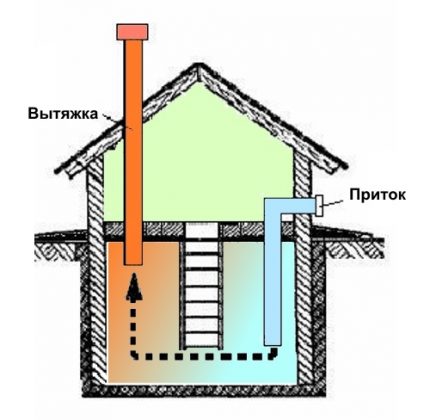
Installation of ventilation in the garage and vegetable pit is as follows:
- In the wall near the garage door with an indentation of 20-30 cm from the ground and through the ceiling downwards, holes for the supply pipe make their way into the cellar.
- Holes for the hood are made in the roof of the garage and the ceiling of the pit.
- Ventilation pipes are mounted (a condensate collector is installed on the hood from the bottom).
- A valve is installed on the air supply pipe.
- If necessary, ventilation ducts are insulated with moisture-resistant polystyrene or foam.
- A rain hood is installed on top of the chimney.
To prevent rodents from climbing into the vegetable storehouse through ventilation, a metal grate should be installed on the outlets of the air flow from the street. At the same time, the distance from the edge of the exhaust pipe to the ceiling of the vegetable pit should not exceed 20 cm, and the supply pipe should rise above its floor by a maximum of 50 cm.
The intake duct in the pit should be positioned so that incoming street air does not get into cans and vegetables. In winter it is cold and should first warm slightly.
Otherwise, the total temperature in the cellar will be at +5 0C, and locally near the ventilation pipe everything will freeze. For the same reason, this ventilation duct should be diverted from the wall by at least 30-50 cm so that a frost coat from frost does not grow next to it.
Introduces the rules and formulas for calculating the area of ducts next article, which we recommend independent home craftsmen.
Conclusions and useful video on the topic
Ventilation in the vegetable store under the garage:
How to make ventilation in a vegetable pit:
The owners, deciding how best to arrange ventilation in the garage vegetable pit, have only two options. You can make a forced system with a fan or arrange air exchange with natural air circulation. The first method is volatile and expensive, but also effective in any weather.
In the vast majority of cases, just the second one is used. Pairs of pipes to the inflow and exhaust, diagonally spaced in the cellar at different angles, are usually quite enough to provide the required level of air exchange in the room in question.
You still have questions about the topic or have your own comments on how to properly make ventilation in the vegetable store in the garage - write below. We will certainly help you understand all the nuances of organizing ventilation in a vegetable cellar.

 Inspection pit ventilation in a garage: specifics of arranging an air exchange system
Inspection pit ventilation in a garage: specifics of arranging an air exchange system  Do-it-yourself ventilation of the cellar in the garage: installation methods and procedures + useful tips for arranging
Do-it-yourself ventilation of the cellar in the garage: installation methods and procedures + useful tips for arranging 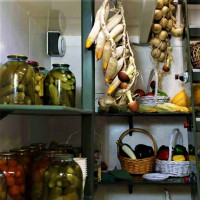 Basement ventilation in a private house: the best ways to arrange proper air exchange
Basement ventilation in a private house: the best ways to arrange proper air exchange  Is forced ventilation in the bathroom necessary: norms and stages of arranging efficient air exchange
Is forced ventilation in the bathroom necessary: norms and stages of arranging efficient air exchange 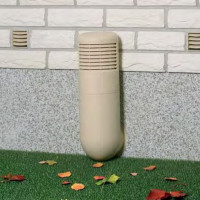 Ground floor ventilation: general arrangement technology + effective air exchange methods
Ground floor ventilation: general arrangement technology + effective air exchange methods  DIY ventilation in the workshop: options and principles for arranging an air exchange system
DIY ventilation in the workshop: options and principles for arranging an air exchange system  How much does it cost to connect gas to a private house: the price of organizing gas supply
How much does it cost to connect gas to a private house: the price of organizing gas supply  The best washing machines with dryer: model rating and customer tips
The best washing machines with dryer: model rating and customer tips  What is the color temperature of light and the nuances of choosing the temperature of the lamps to suit your needs
What is the color temperature of light and the nuances of choosing the temperature of the lamps to suit your needs  Replacement of a geyser in an apartment: replacement paperwork + basic norms and requirements
Replacement of a geyser in an apartment: replacement paperwork + basic norms and requirements